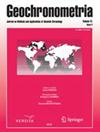Luminescence Chronology of the Yellow River Terraces in the Heiyukou Area, China, and Its Implication for the Uplift Rate of the Ordos Plateau
IF 0.9
4区 地球科学
Q3 Earth and Planetary Sciences
引用次数: 3
Abstract
Abstract The precise chronology of the fluvial terraces of the Yellow River in China is essential to understand its geomorphological evolution history. More terrace ages are needed for the correlation of the terraces along the river and the construction of the longitudinal profile. In this study, seven terraces (T1–T7) in the Heiyukou area of the Jinshaan Canyon of the river were identified and were sampled for optical dating. The reliability of the ages was evaluated on the bases of bleachability, comparison of optical ages on fine and coarse grains, stratigraphic consistency of OSL ages, age distribution and geomorphological setting. The results show that the paired T2 terrace was formed at 72 ± 3 ka, and the T4, T5 strath terraces were dated to 108 ± 4 and >141 ± 4 ka, respectively. The ages for the samples from T6 and T7 were significantly underestimated, and the ‘infinitely old’ pre-Quaternary Red-Clay sample on the T7 terrace was dated to 134 ± 6 ka. The long-term river incision rates were calculated to be <0.36, 0.34 and 0.18 mm/a for at least the past 141, 108 and 72 ka, respectively, which also reflect the uplift rates of the Ordos plateau. The implication for dating terrace deposits is that terraces should be systemically sampled and dated using both fine and coarse grain fractions. The reliability of the ages obtained for high terraces should be evaluated using a relative chronology of dated samples on a case-by-case basis, if no independent numerical age controls are available.黑裕口地区黄河阶地的发光年代学及其对鄂尔多斯高原隆升速率的指示
黄河河流阶地的精确年代学对了解其地貌演化历史至关重要。沿河阶地的对比和纵剖面的构建需要更多的阶地年代。本文对金山河峡谷黑峪口地区的7个阶地(t1 ~ t7)进行了鉴定,并进行了光学测年。根据可漂白性、细粒和粗粒光学年龄对比、OSL年龄的地层一致性、年龄分布和地貌背景对年龄的可靠性进行了评价。结果表明,配对的T2阶地形成于72±3 ka, T4、T5阶地形成于108±4 ka和>141±4 ka。T6和T7阶地样品的年龄被明显低估,T7阶地的“无限老”前第四纪红粘土样品的年龄为134±6 ka。至少在过去141、108和72 ka,河流切割速率分别<0.36、0.34和0.18 mm/a,这也反映了鄂尔多斯高原的隆升速率。对阶地沉积物定年的启示是,阶地应该用细粒和粗粒组分系统地取样和定年。如果没有独立的数字年龄控制,高阶地年龄的可靠性应该在个案的基础上,使用年代样本的相对年表来评估。
本文章由计算机程序翻译,如有差异,请以英文原文为准。
求助全文
约1分钟内获得全文
求助全文
来源期刊

Geochronometria
地学-地球科学综合
CiteScore
2.20
自引率
0.00%
发文量
1
审稿时长
>12 weeks
期刊介绍:
Geochronometria is aimed at integrating scientists developing different methods of absolute chronology and using them in different fields of earth and other natural sciences and archaeology. The methods in use are e.g. radiocarbon, stable isotopes, isotopes of natural decay series, optically stimulated luminescence, thermoluminescence, EPR/ESR, dendrochronology, varve chronology. The journal publishes papers that are devoted to developing the dating methods as well as studies concentrating on their applications in geology, palaeoclimatology, palaeobiology, palaeohydrology, geocgraphy and archaeology etc.
 求助内容:
求助内容: 应助结果提醒方式:
应助结果提醒方式:


